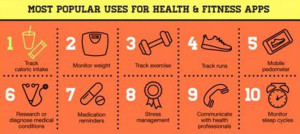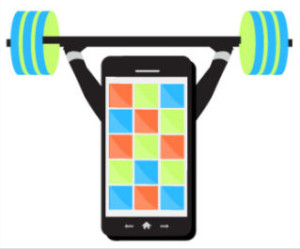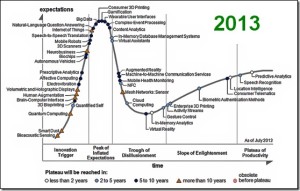 Over half of people using health and fitness apps began using them over six months ago, and one-half of these people who have downloaded health and fitness apps use them daily according to survey research summarized in the report, Get Mobile, Get Healthy: The Appification of Health and Fitness from Mobiquity.
Over half of people using health and fitness apps began using them over six months ago, and one-half of these people who have downloaded health and fitness apps use them daily according to survey research summarized in the report, Get Mobile, Get Healthy: The Appification of Health and Fitness from Mobiquity.
The company contracted a survey conducted among 1,000 U.S. adults in March 2014 who use or plan to use mobile apps to track health and fitness. Thus the “N” in this study was a group of people already interested in self-tracking health and not representative of the broader U.S. consumer population.
Mobiquity points out the fast-growth of mobile apps available in app stores, increasing by 19% in 2013. “These apps are just the onset of a tectonic shift in how mobility will transform the healthcare industry,” the report asserts in the introduction. The company expects that 2014 will be the year mobile health makes “the leap from early adopters to mainstream” adoption.
 Among the 1,000 consumers polled — who are already interested in using or adopting mobile health — 55% plan to use wearable devices to track health and fitness in the future, and 69% said tracking their health and fitness via smartphone is or will become more important than going mobile for social networking. A majority of the consumers surveyed told Mobiquity that using a smartphone to track health and fitness is more important than using the device to shop, play games, read the news, listen to music, check weather, use calendars, and do research (e.g., via Google).
Among the 1,000 consumers polled — who are already interested in using or adopting mobile health — 55% plan to use wearable devices to track health and fitness in the future, and 69% said tracking their health and fitness via smartphone is or will become more important than going mobile for social networking. A majority of the consumers surveyed told Mobiquity that using a smartphone to track health and fitness is more important than using the device to shop, play games, read the news, listen to music, check weather, use calendars, and do research (e.g., via Google).
Among those people who have been using mobile health apps, most learned they are eating more calories than they had thought before tracking their food intake via app, and 23% found out they walked less than they had perceived. The most popular uses for health and fitness apps, shown in the first chart, are tracking food, weight, exercise, running, and steps (via pedometer); and, conducting medical research, using medication reminders, managing stress, communicating with clinicians, and monitoring sleep.
1 in 3 consumers said they would be more likely to use health apps if their doctors recommended them. But 1 in 3 people also stop using health and fitness apps do to forgetting, time constraints, difficult with the tools (“it’s too hard), and reaching goals. Another important finding: 61% of people in the survey cited privacy concerns were the key reason stopping them from using health apps more.
60% of mobile health app users have not shared their findings with doctors – most haven’t even thought about sharing. Of the 40% of users who have shared with doctors, most said the doctor was interested in their findings.
Health Populi’s Hot Points: The mass middle of America still needs convincing — starting with exposure — to the merits of self-tracking. If this is done right, we’ll weave a new riff on health literacy, combining technology, mobile, digital, and self-awareness along with solid messaging on nutrition for health consumers who are balancing busy lives, paychecks, job security, child-rearing, and overweight (which is a key condition mobile health can help address).
A device-for-device-sake will end up in the sock drawer within 90 days, which is the anecdotal story about health wearables to-date.
Gartner’s Hype Cycle for 2013 tells us that #wearables are at the Peak of Inflated Expectations right now, shown in the second chart. Mobiquity’s findings demonstrate that most people who stick to using mobile health apps are finding value in the process. Understanding those happy users’ underlying values and experiences will help developers design devices, interfaces, and motivation structures that will attract and retain new users over time. There are reasons why a small group of consumers has been early adopters. Getting to the mass middle will help move the category of mobile health apps beyond Inflated Expectations to the Slope of Enlightenment — and better health outcomes.





 I'm in amazing company here with other #digitalhealth innovators, thinkers and doers. Thank you to Cristian Cortez Fernandez and Zallud for this recognition; I'm grateful.
I'm in amazing company here with other #digitalhealth innovators, thinkers and doers. Thank you to Cristian Cortez Fernandez and Zallud for this recognition; I'm grateful. Jane was named as a member of the AHIP 2024 Advisory Board, joining some valued colleagues to prepare for the challenges and opportunities facing health plans, systems, and other industry stakeholders.
Jane was named as a member of the AHIP 2024 Advisory Board, joining some valued colleagues to prepare for the challenges and opportunities facing health plans, systems, and other industry stakeholders.  Join Jane at AHIP's annual meeting in Las Vegas: I'll be speaking, moderating a panel, and providing thought leadership on health consumers and bolstering equity, empowerment, and self-care.
Join Jane at AHIP's annual meeting in Las Vegas: I'll be speaking, moderating a panel, and providing thought leadership on health consumers and bolstering equity, empowerment, and self-care.